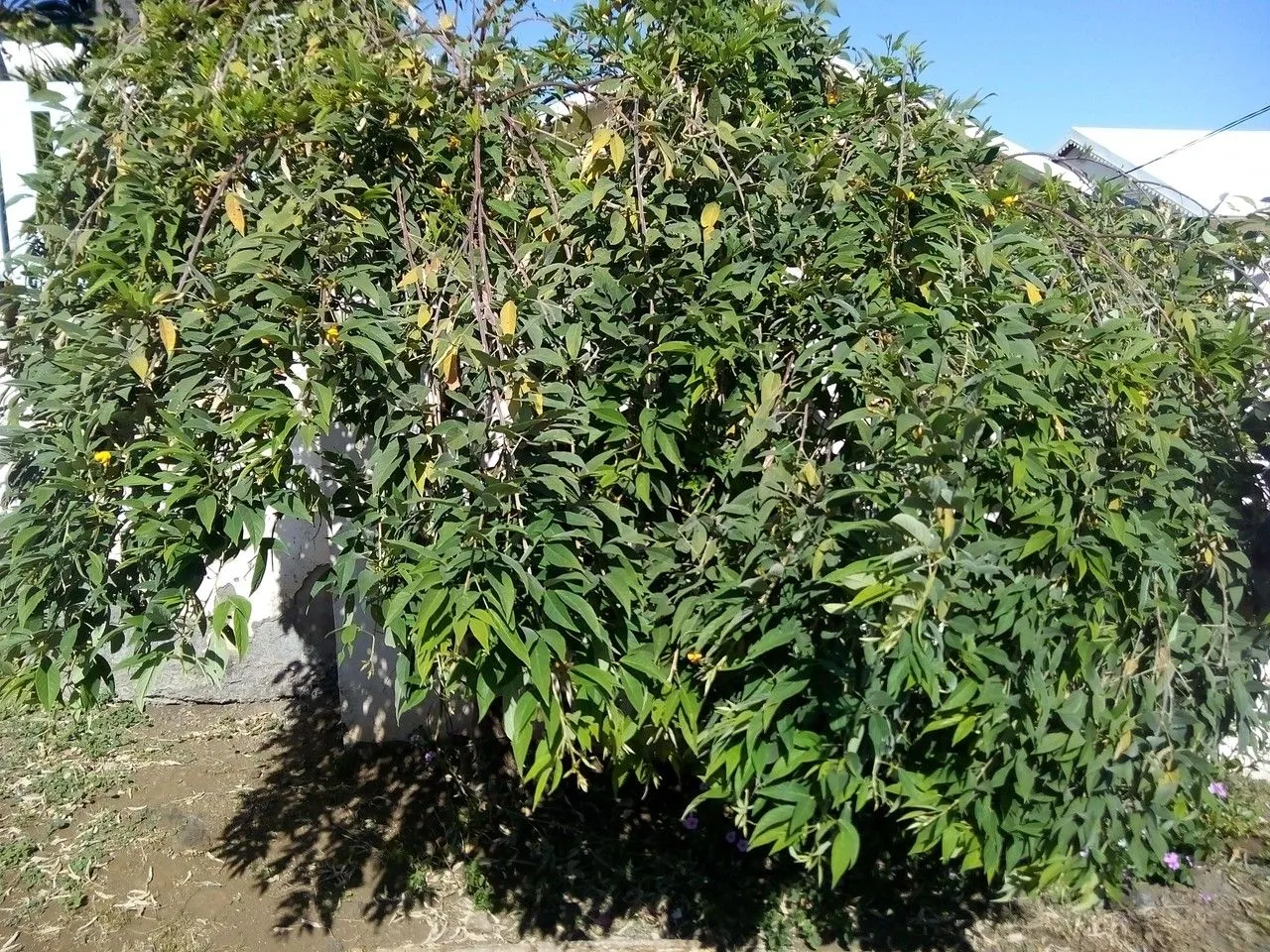
Author: Millsp. (L.)
Bibliography: Helios 11: 133 (1893)
Year: 1893
Status: accepted
Rank: species
Genus: Cajanus
Vegetable: True
Observations: Indian Subcontinent
Pigeonpea, a perennial legume known by its scientific name Cajanus cajan, holds significant agricultural and nutritional value, particularly in tropical and subtropical regions. First documented in the scientific literature by Millsp. in 1893, the plant has garnered attention for its robust adaptability and benefits to both soil health and human diets.
Native to the Indian Subcontinent, pigeonpea has been cultivated for thousands of years, figuring prominently in traditional farming systems and local cuisines. This leguminous plant belongs to the Fabaceae family, known for its nitrogen-fixing capabilities, which enrich the soil by converting atmospheric nitrogen into a form usable by plants. This natural fertilization process reduces the need for chemical fertilizers, promoting sustainable agricultural practices.
The pigeonpea plant is well-suited to withstand the environmental stresses typical of semi-arid regions, such as drought and poor soil conditions. It has a deep taproot system that allows it to access water and nutrients from deeper soil layers, contributing to its resilience and making it a valuable crop in regions facing water scarcity. Additionally, pigeonpea can be intercropped with other staple crops, such as cereals, which enhances biodiversity and leads to better resource utilization.
Nutritionally, pigeonpea boasts a high protein content, making it an essential component of the diet in many developing countries where protein deficiency is prevalent. Its seeds are rich in essential amino acids, minerals, and vitamins, providing a balanced protein source when combined with cereals or grains. This makes pigeonpea a cornerstone in the fight against malnutrition.
The versatility of pigeonpea extends beyond its nutritional benefits. It is utilized in various culinary preparations across the globe. In India, for instance, it is a key ingredient in the popular dish ‘dal,’ where the split pulses are cooked with spices and served with rice or bread. Its young pods and leaves are also edible and used in various traditional recipes.
In conclusion, pigeonpea (Cajanus cajan) is a multifaceted crop that plays a critical role in sustainable agriculture, food security, and nutrition, especially within the Indian Subcontinent. Its ability to improve soil fertility, endure harsh climates, and provide essential nutrients highlights its importance and potential for fostering resilient agricultural communities.
Eng: congo-pea, pigeonpea, pigeon-pea, red gram, yellow dhal
Deu: straucherbse
Fra: ambrévade, pois d’angole
Spa: cachito, gandul
Swe: duvärt
Por: ervilha-de-angola, feijão-guandu, feijão-guandú, guandeiro, guando, guandú, guisante-de-angola
Ita: pisello del tropico
En: Pigeonpea, Congo Bean, Dhal, Pigeon Pea, Tropical green pea, Yellow dhal, Guḍi, Undis
Af: Duif-ertjie, Kongo-boontjie
Ar: البازلاء الهندية (البسلة)
Az: Göyərçin noxudu
Bm: Jo yeri
Bn: অড়হর
Ny: Nandalo
Zh: 木豆
Cs: Kajan indický
Dv: މުގު ތޮޅި
Eo: Kajano
Et: Harilik tuvihernes
Fi: Kyyhkynherne
Fr: Pois d’Angole, Pois de bois, Pois d’angole, Pois d’Angola, Pois en gaules, Ambrevade, Zambrevate
Ka: Მტრედიცერცვა
De: Katjangstrauch, Strauchbohne, Straucherbse, Straucherbsenbaum, Taubenerbse, Taubenerbsenbaum
Gn: Kumanda yvyra’i
Gu: તુવેર
Ht: Pwa kongo
Ha: Waaken Santanbul
Hi: अरहर, अरहर दाल
Hu: Galambborsó
Is: Dúfnabaun
Id: Kacang gude
Jv: Kacang dara
Kn: ತೊಗರಿ ಕಾಳು
Rw: Umukunde, Omokunde
Ko: 비둘기콩
Mk: Гулабов грашок
Ms: Kacang dal
Ml: തുവര
Mr: तूर
Ne: रहर(दाल)
No: Ertebønne
Or: ହରଡ଼
Pa: ਅਰਹਰ
Fa: نخود کفتری
Pt: Guandu
Ru: Голубиный горох
Sa: तुवरी
Es: Chícharo, Quinchoncho
Su: Hiris
Sw: Mbaazi
Tl: Kadyos
Zh-tw: 木豆
Ta: துவரை
Te: కందులు
To: Pī kula
Vi: Đậu triều
© copyright of the Board of Trustees of the Royal Botanic Gardens, Kew.
© copyright of the Board of Trustees of the Royal Botanic Gardens, Kew.
© copyright of the Board of Trustees of the Royal Botanic Gardens, Kew.
Taken Jan 7, 2021 by zuñiga Eduardo (cc-by-sa)
Taken Oct 16, 2019 by Ernita (cc-by-sa)
Taken May 24, 2019 by Vincent finger (cc-by-sa)
Taken Feb 9, 2021 by Oliveira Vander (cc-by-sa)
Taken Mar 27, 2022 by Nurviyanty Dewi Yanie (cc-by-sa)
Taken Jul 11, 2021 by bruno vergnes (cc-by-sa)
Taken Jul 29, 2022 by laurent00031 (cc-by-sa)
Taken Jul 29, 2022 by laurent00031 (cc-by-sa)
Taken May 29, 2016 by Hugo SANTACREU (cc-by-sa)
Taken Mar 27, 2022 by Nurviyanty Dewi Yanie (cc-by-sa)
Taken Dec 14, 2019 by corentin fleury (cc-by-sa)
Taken Jul 28, 2015 by Tela Botanica − Anziz AHMED ABDOU (cc-by-sa)
Taken Oct 22, 2021 by carole lacaille (cc-by-sa)
Taken Jan 4, 2020 by Dieter Albrecht (cc-by-sa)
Taken Mar 27, 2022 by Nurviyanty Dewi Yanie (cc-by-sa)
Taken Jan 4, 2020 by Dieter Albrecht (cc-by-sa)
Taken Jan 1, 1900 by EOL − Howard, R.A. (cc-by-nc-sa)
Taken Jul 28, 2015 by Tela Botanica − Anziz AHMED ABDOU (cc-by-sa)
Taken Jul 28, 2015 by Tela Botanica − Anziz AHMED ABDOU (cc-by-sa)
Taken Jul 28, 2015 by Tela Botanica − Anziz AHMED ABDOU (cc-by-sa)
Taken Jul 28, 2015 by Tela Botanica − Anziz AHMED ABDOU (cc-by-sa)
Taken Jul 28, 2015 by Tela Botanica − Anziz AHMED ABDOU (cc-by-sa)
Taken Jul 28, 2015 by Tela Botanica − Anziz AHMED ABDOU (cc-by-sa)
Taken Jul 28, 2015 by Tela Botanica − Anziz AHMED ABDOU (cc-by-sa)
Taken Jul 28, 2015 by Tela Botanica − Anziz AHMED ABDOU (cc-by-sa)
Taken Feb 15, 2017 by Photoflora – Benoit BOCK (©)
Taken Feb 15, 2017 by Photoflora – Benoit BOCK (©)
Taken Feb 15, 2017 by Photoflora – Benoit BOCK (©)
Taken Jul 28, 2015 by Tela Botanica − Anziz AHMED ABDOU (cc-by-sa)
Taken Jul 28, 2015 by Tela Botanica − Anziz AHMED ABDOU (cc-by-sa)
Family: Myrtaceae Author: (F.Muell.) K.D.Hill & L.A.S.Johnson Bibliography: Telopea 6: 402 (1995) Year: 1995 Status:…
Family: Rubiaceae Author: Pierre ex A.Froehner Bibliography: Notizbl. Bot. Gart. Berlin-Dahlem 1: 237 (1897) Year:…
Family: Sapindaceae Author: Koidz. Bibliography: J. Coll. Sci. Imp. Univ. Tokyo 32(1): 38 (1911) Year:…
Family: Asteraceae Author: A.Gray Bibliography: Pacif. Railr. Rep.: 107 (1857) Year: 1857 Status: accepted Rank:…
Family: Fabaceae Author: Medik. Bibliography: Vorles. Churpfälz. Phys.-Ökon. Ges. 2: 398 (1787) Year: 1787 Status:…
Family: Aspleniaceae Author: (Cav.) Alston Bibliography: Bull. Misc. Inform. Kew 1932: 309 (1932) Year: 1932…